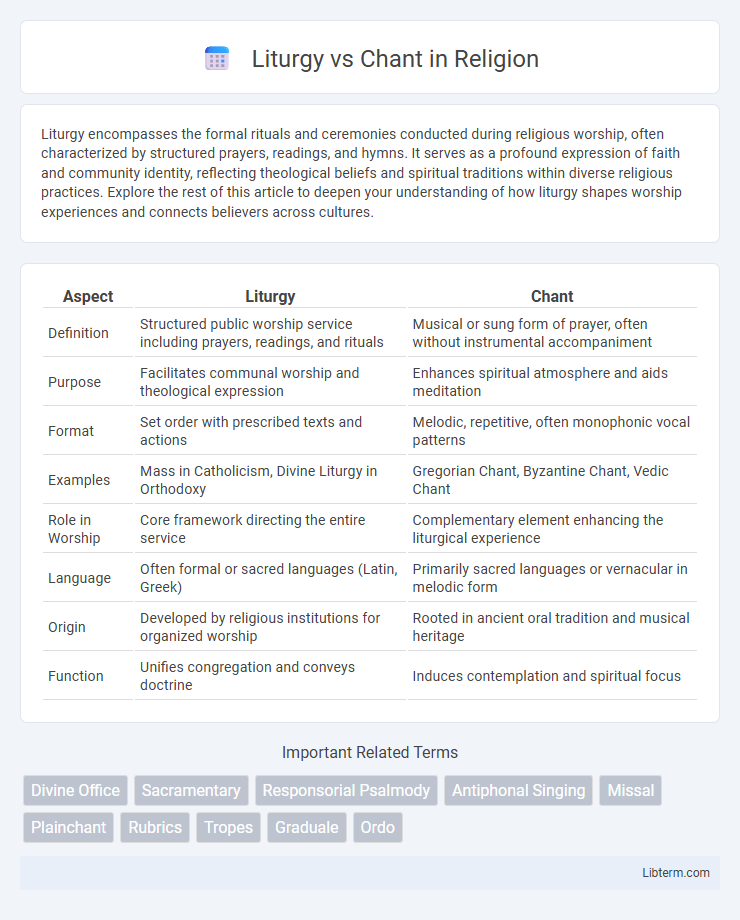Liturgy encompasses the formal rituals and ceremonies conducted during religious worship, often characterized by structured prayers, readings, and hymns. It serves as a profound expression of faith and community identity, reflecting theological beliefs and spiritual traditions within diverse religious practices. Explore the rest of this article to deepen your understanding of how liturgy shapes worship experiences and connects believers across cultures.
Table of Comparison
| Aspect | Liturgy | Chant |
|---|---|---|
| Definition | Structured public worship service including prayers, readings, and rituals | Musical or sung form of prayer, often without instrumental accompaniment |
| Purpose | Facilitates communal worship and theological expression | Enhances spiritual atmosphere and aids meditation |
| Format | Set order with prescribed texts and actions | Melodic, repetitive, often monophonic vocal patterns |
| Examples | Mass in Catholicism, Divine Liturgy in Orthodoxy | Gregorian Chant, Byzantine Chant, Vedic Chant |
| Role in Worship | Core framework directing the entire service | Complementary element enhancing the liturgical experience |
| Language | Often formal or sacred languages (Latin, Greek) | Primarily sacred languages or vernacular in melodic form |
| Origin | Developed by religious institutions for organized worship | Rooted in ancient oral tradition and musical heritage |
| Function | Unifies congregation and conveys doctrine | Induces contemplation and spiritual focus |
Introduction to Liturgy and Chant
Liturgy represents the structured public worship rituals and ceremonies performed by religious communities, often following ancient traditions and specific texts. Chant refers to the melodic vocal music used to enhance the liturgical experience, characterized by repetitive, monophonic melodies that facilitate meditation and prayer. Understanding the relationship between liturgy and chant is essential to appreciating how sacred music supports religious practices and spiritual engagement.
Defining Liturgy: Structure and Purpose
Liturgy refers to the fixed set of rituals, prayers, and ceremonies conducted in religious worship, embodying a structured framework that guides communal devotion and spiritual practice. It establishes a sequence of worship elements designed to facilitate divine communication, reflection, and participation within a faith tradition. The primary purpose of liturgy is to create a unified worship experience that reinforces doctrinal beliefs and fosters a sense of sacred order.
Understanding Chant: Origins and Forms
Chant originated in early Christian worship as a monophonic, unaccompanied vocal music form designed to enhance liturgical texts and facilitate congregational participation. Its primary forms include Gregorian chant, characterized by free-flowing melodies based on Latin liturgical texts, and Byzantine chant, known for its modal scales and intricate ornamentation. Understanding these origins and variations reveals chant's role in shaping the spiritual and musical dimensions of Christian liturgy.
Historical Development of Liturgy and Chant
The historical development of liturgy and chant traces back to early Christian worship practices where liturgy established structured rituals for communal worship, while chant evolved as a musical form to enhance these rituals. Gregorian chant, emerging in the 9th and 10th centuries, became the dominant form of plainchant used in Western liturgical services, influencing the spiritual and cultural identity of the medieval church. The codification of liturgical texts and melodies reflects the intertwined growth of religious doctrine and musical tradition from the early Middle Ages through the Renaissance.
Key Differences between Liturgy and Chant
Liturgy encompasses the structured set of religious rituals and practices performed during worship services, often including prayers, readings, and ceremonies, while chant refers specifically to the melodic vocalization of sacred texts or hymns used within those services. The key difference lies in liturgy being the overall framework of worship, incorporating various elements including chant, which serves as a musical and meditative component to enhance spiritual experience. Chant is typically repetitive and monophonic, designed to facilitate congregational participation or clerical recitation, whereas liturgy dictates the order and content of the entire worship service.
The Role of Chant within the Liturgy
Chant serves as a foundational element within the liturgy, enhancing the sacred atmosphere through melodic vocal expressions that unify congregational worship. It facilitates the proclamation of liturgical texts, guiding the assembly's participation and emphasizing key theological themes. The integration of chant preserves ancient traditions while enriching the ritual's spiritual depth and communal cohesion.
Cultural Variations in Liturgy and Chant
Cultural variations in liturgy and chant reflect the diverse religious traditions and historical contexts of global communities, with Eastern Orthodox liturgies featuring Byzantine chant characterized by intricate modal scales, while Western Catholic liturgies often incorporate Gregorian chant known for its monophonic texture. African liturgical practices may incorporate vibrant rhythmic chants and call-and-response patterns that emphasize communal participation, contrasting with the solemnity and structured melodies found in traditional European settings. These cultural distinctions highlight how liturgical chants serve both as expressions of faith and as vehicles for preserving unique cultural identities within worship.
Influence of Chant on Worship Experience
Chant profoundly shapes the worship experience by enhancing congregational participation and fostering a meditative atmosphere through its rhythmic and melodic patterns. The integration of chant into liturgy emphasizes sacred texts, facilitating deeper spiritual reflection and emotional connection during services. This ancient vocal tradition sustains communal identity and continuity, enriching the overall liturgical practice with its historical and theological significance.
Modern Approaches to Liturgy and Chant
Modern approaches to liturgy emphasize contextual adaptability, integrating contemporary language and multimedia elements to foster active participation and spiritual engagement. Innovations in chant involve blending traditional Gregorian melodies with diverse musical styles and technology-enhanced performances to appeal to broader congregations. Both fields prioritize inclusivity and cultural relevance while preserving their historical and theological foundations.
Conclusion: Liturgy and Chant in Contemporary Practice
Liturgy and chant retain vital roles in contemporary worship, where liturgy structures the communal ritual framework and chant enriches the spiritual atmosphere through melodic tradition. Modern practice increasingly integrates diverse musical styles with traditional chant to enhance congregational engagement and foster deeper spiritual connection. Ongoing scholarship and innovation ensure that liturgy and chant evolve while preserving their historical and cultural significance within faith communities.
Liturgy Infographic

 libterm.com
libterm.com